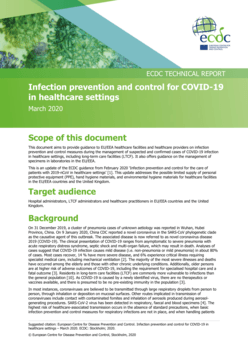Hello! You're looking at a policy document report on Overton
We track government policy, guidelines, think tank research, working papers and more to help our customers see the impact and influence of their work. Are you interested in seeing what information we have to offer? Request a free trial to our platform.
If you fund, produce or manage research or work to influence policy, we'd love to talk. Learn more on our homepage.

Infection prevention and control for COVID-19 in healthcare settings
This document aims to provide guidance to EU/EEA healthcare facilities and healthcare providers on infection prevention and control measures during the management of suspected and confirmed cases of COVID-19 infection in healthcare settings, including long-term care facilities (LTCF). It also offers guidance on the management of specimens in laboratories in the EU/EEA.
Topics in this document
Public health
Infection control
Personal protective equipment
Isolation (health care)
Infection
Surgical mask
Transmission (medicine)
Hygiene
Health care
Hand washing
Medicine
Health sciences
Health
Medical specialties
Coronavirus disease 2019
Clinical medicine
Respirator
Surgery
Severe acute respiratory syndrome coronavirus 2
Health professional
Hospital
Diseases and disorders
Patient
Medical humanities
Disinfectant
Sodium hypochlorite
Severe acute respiratory syndrome
Epidemiology
Related SDGs
SDG 3: Good Health and Well-being ...
SDG 3: Good Health and Well-being
Target 3.3
End the epidemics of AIDS, tuberculosis, malaria and neglected tropical diseases and combat hepatitis, water-borne diseases and other communicable diseases
Target 3.d
Strengthen the capacity of all countries, in particular developing countries, for early warning, risk reduction and management of national and global health risk
Citations
Cited by 86
other policy documents
(75 of them are from other policy sources)
